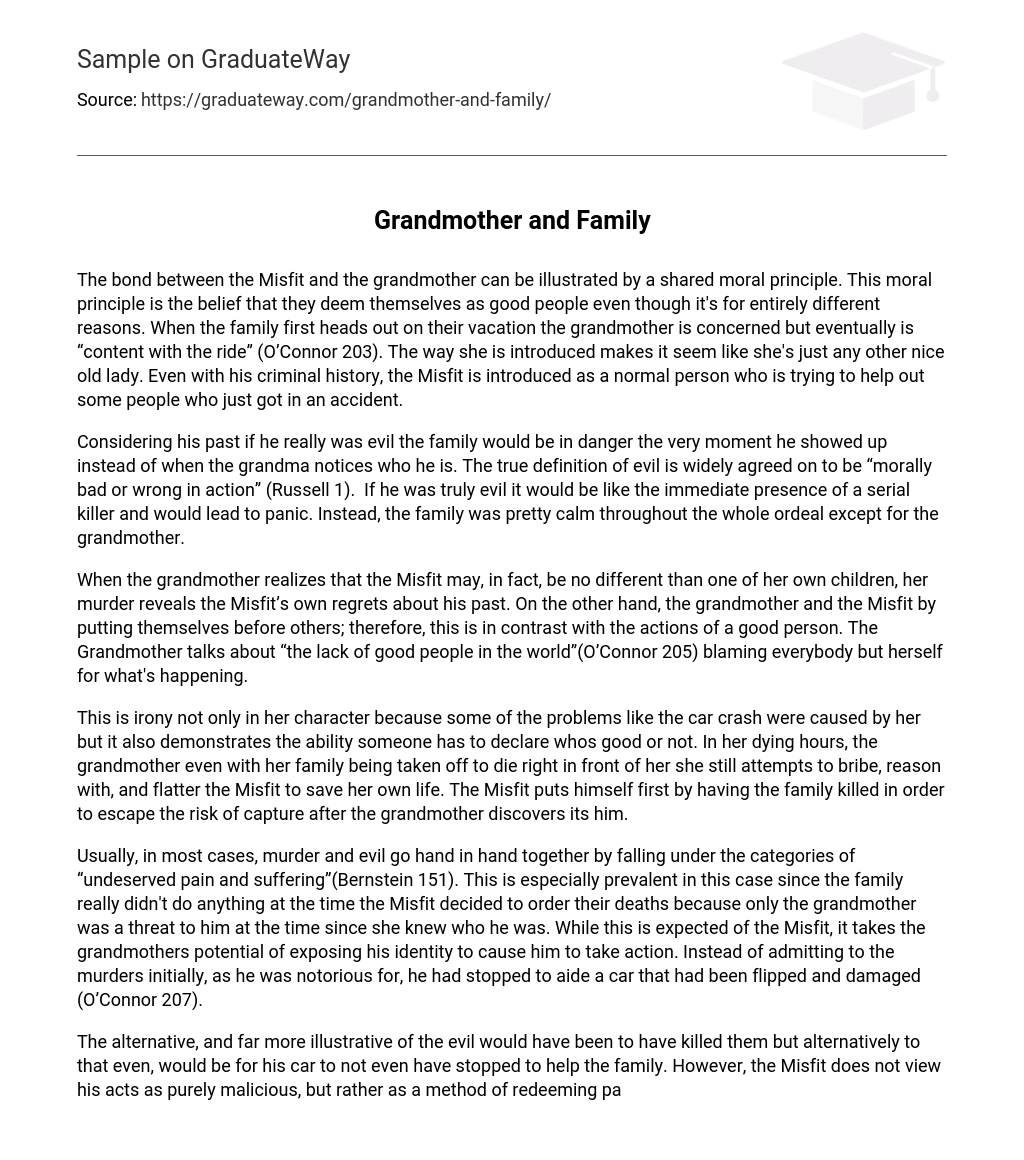The bond between the Misfit and the grandmother can be illustrated by a shared moral principle. This moral principle is the belief that they deem themselves as good people even though it’s for entirely different reasons. When the family first heads out on their vacation the grandmother is concerned but eventually is “content with the ride” (O’Connor 203). The way she is introduced makes it seem like she’s just any other nice old lady. Even with his criminal history, the Misfit is introduced as a normal person who is trying to help out some people who just got in an accident.
Considering his past if he really was evil the family would be in danger the very moment he showed up instead of when the grandma notices who he is. The true definition of evil is widely agreed on to be “morally bad or wrong in action” (Russell 1). If he was truly evil it would be like the immediate presence of a serial killer and would lead to panic. Instead, the family was pretty calm throughout the whole ordeal except for the grandmother.
When the grandmother realizes that the Misfit may, in fact, be no different than one of her own children, her murder reveals the Misfit’s own regrets about his past. On the other hand, the grandmother and the Misfit by putting themselves before others; therefore, this is in contrast with the actions of a good person. The Grandmother talks about “the lack of good people in the world”(O’Connor 205) blaming everybody but herself for what’s happening.
This is irony not only in her character because some of the problems like the car crash were caused by her but it also demonstrates the ability someone has to declare whos good or not. In her dying hours, the grandmother even with her family being taken off to die right in front of her she still attempts to bribe, reason with, and flatter the Misfit to save her own life. The Misfit puts himself first by having the family killed in order to escape the risk of capture after the grandmother discovers its him.
Usually, in most cases, murder and evil go hand in hand together by falling under the categories of “undeserved pain and suffering”(Bernstein 151). This is especially prevalent in this case since the family really didn’t do anything at the time the Misfit decided to order their deaths because only the grandmother was a threat to him at the time since she knew who he was. While this is expected of the Misfit, it takes the grandmothers potential of exposing his identity to cause him to take action. Instead of admitting to the murders initially, as he was notorious for, he had stopped to aide a car that had been flipped and damaged (O’Connor 207).
The alternative, and far more illustrative of the evil would have been to have killed them but alternatively to that even, would be for his car to not even have stopped to help the family. However, the Misfit does not view his acts as purely malicious, but rather as a method of redeeming past actions as he says “… I can’t make what all I done wrong fit what all I gone through in punishment” (O’Connor 211). This quote from the Misfit also supports the idea of propositional faith which is “One can have faith that something is so only if one is for it, at least in the sense that one considers its truth to be good or desirable” (Snyder 362).
This perspective allows the Misfit to continue what he’s doing but instead be seen as a redeemer of himself, in an attempt to make the punishment he has already received, deserved.Despite their differences, both the grandmother and the Misfit learn from the violent acts perpetrated that neither is entirely good or evil. Richard Kane notes that “destruction can be positive and that evil may be the agent of good” (Kane 45). In the moments before her death, the grandmother shared an emotional connection with the Misfit revealing that under different circumstances he “wouldn’t be like he is now” (O’Connor 211).
This emotional connection illustrates a common understanding of good and evil between the two. The Misfit closes the story by saying that he wants to have some purpose in his life because the killing was no longer fun to him. He could not take joy in murder, nor could he let his associates make light of the taking of the life of someone who, in his eyes, could have been a good person, by his standards. Prior to that execution, the grandmother had finally realized that the goodness of a person is merely a subject of context.
As the Misfit is on the verge of tears the grandmother sees, in him, some quality that connects someone she loves, in this case, “one of her own children” (O’Connor 211). It is this character complexity that makes each character unique and makes it difficult to call any one of these characters good or evil. Whether it is the grandmother transitioning from telling her grandchildren stories to pass the time as a loving grandmother would leading to her eventual acts of self-preservation or the Misfit’s acts of generosity in helping her family and his directions to have them killed, it can be seen that their actions dictate how they are seen and how they may be looked at by readers.





